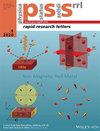通过介电掩模静电沉积气溶胶金纳米粒子,实现导电微结构的高分辨率图案化
IF 2
4区 物理与天体物理
Q3 MATERIALS SCIENCE, MULTIDISCIPLINARY
引用次数: 0
摘要
这项工作开发并研究了一种新方法,即通过电带掩膜对纳米粒子进行静电聚焦,以形成 10 μm 的窄导电微结构。该方法类似于通过模板沉积材料,可获得比掩膜间隙宽度小 15 倍的线条。建议使用普通 PVC 电工胶带作为掩膜,而不是昂贵的光阻剂或电子阻剂。这项工作研究了掩膜厚度(高度)为 60-180 μm、间隙宽度为 120-380 μm、基底电位为 0.1-5 kV、沉积时间为 10 分钟和 120 分钟对线条的几何形状和电气特性的影响。基底材料是硅,通过火花放电合成的 60 纳米带电金纳米颗粒是微结构的组成元素。在 COMSOL 中对纳米粒子的聚焦过程进行的数值建模定性地证实了所发现的实验相关性。烧结线的电阻率是块状金的 6.34 倍。所开发的方法可以获得高视角的微结构,支持在大气压力下操作,并可灵活控制材料的选择。本文受版权保护。本文章由计算机程序翻译,如有差异,请以英文原文为准。
High‐resolution patterning of conductive microstructures by electrostatic deposition of aerosol Au nanoparticles through the dielectric mask
A new approach of electrostatically focusing nanoparticles through an electrical tape mask to form narrow <10 μm and conductive microstructures is developed and investigated in this work. The presented approach is similar to deposition of material through a stencil and allows one to obtain lines 15 times smaller than the width of the gap in the mask. It is proposed to use ordinary PVC electrical tape as a mask instead of expensive photo or electronic resists. The work investigated the influence of a mask thickness (height) of 60–180 μm , a gap width of 120–380 μm , a substrate potential of 0.1–5 kV, and a deposition time of 10 and 120 min on the geometry and electrical properties of the lines. The substrate material was Si, and charged Au nanoparticles 60 nm in size synthesized by spark discharge were the building blocks of microstructures. Numerical modeling of the process of focusing nanoparticles in COMSOL qualitatively confirmed the found experimental dependencies. The electrical resistivity of the sintered lines is 6.34 times higher than that of bulk gold. The developed approach makes it possible to obtain high‐aspect microstructures, supports operation at atmospheric pressure, and is flexibly controlled in terms of the choice of materials.This article is protected by copyright. All rights reserved.
求助全文
通过发布文献求助,成功后即可免费获取论文全文。
去求助
来源期刊

Physica Status Solidi-Rapid Research Letters
物理-材料科学:综合
CiteScore
5.20
自引率
3.60%
发文量
208
审稿时长
1.4 months
期刊介绍:
Physica status solidi (RRL) - Rapid Research Letters was designed to offer extremely fast publication times and is currently one of the fastest double peer-reviewed publication media in solid state and materials physics. Average times are 11 days from submission to first editorial decision, and 12 days from acceptance to online publication. It communicates important findings with a high degree of novelty and need for express publication, as well as other results of immediate interest to the solid-state physics and materials science community. Published Letters require approval by at least two independent reviewers.
The journal covers topics such as preparation, structure and simulation of advanced materials, theoretical and experimental investigations of the atomistic and electronic structure, optical, magnetic, superconducting, ferroelectric and other properties of solids, nanostructures and low-dimensional systems as well as device applications. Rapid Research Letters particularly invites papers from interdisciplinary and emerging new areas of research.
 求助内容:
求助内容: 应助结果提醒方式:
应助结果提醒方式:


